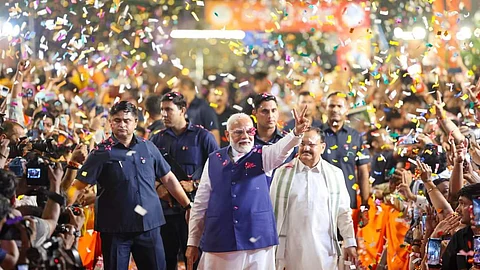

In the 23 years that Narendra Damodardas Modi has spent at the top – first as Chief Minister of Gujarat and then as Prime Minister of India – he has never had to bow to the pressures of running a coalition government. With the BJP slumping to an unexpected low of 240 seats, far short of the much touted figure of 400, the man whose fans call him the ‘Lion of Gujarat’, is set to enter unchartered territory. Although the BJP is still the single largest party and set to form the next government, there are now questions over Modi’s leadership.
As the verdict started to become clear, political commentators went into a tizzy on Tuesday speculating how Modi would steer his government with mercurial partners such as Nitish Kumar of the JDU and N Chandrababu Naidu of the TDP, both of whom have walked out of the NDA once before.
In Naidu’s case, sources said that he will push aggressively for a special financial package for Andhra Pradesh. The INDIA bloc too is not fully out of the race with some leaders suggesting talks with Nitish and Naidu, now and later in six months.
While some felt that a weaker Modi could shed his authoritarian style, others feared that he could turn more aggressive than ever. Speculation is rife that his rivals in the party, who couldn’t imagine questioning his authority until now, are preparing to challenge him and perhaps even unseat him as the Prime Minister.
Addressing party workers, Modi sought to allay fears over his leadership by pointing to the fact that no PM has posted three consecutive wins since 1962. “Big decisions will be taken in the next term, this is Modi’s guarantee,” he announced while stressing that his government’s anti-corruption drive will continue.
Choosing to focus on the positives, he started his speech with the slogan “Jai Jagannath” to bring attention to the BJP’s historic win in the Odisha Assembly elections where it broke the BJD’s run of 24 years in power.
He also pointed to the significant inroads the party has made in the southern states, particularly in Kerala and Telangana. The BJP finally opened its account in Kerala with actor-turned-politician Suresh Gopi winning the Thrissur seat with a margin of nearly 75,000 votes. And in Telangana, the party doubled its tally of seats from 4 in 2019 to 8, in an election that saw the BRS being wiped out.
Although Modi’s words sought to convey strength, his body language seemed to tell a different story. Many observers said he seemed chastened by the verdict; even his supporters were quick to defend him saying he was tired after a gruelling campaign.
His defiant words belied the fact that the party suffered some shocking setbacks, particularly in Uttar Pradesh, which had turned into the epicentre of the Hindutva movement in the last decade of Modi’s rule. The opposition latched on to the fact that the party was defeated in Ayodhya of all places, from where it launched its Ram Janmabhoomi movement.
On June 4 evening, addressing the BJP cadre, party president JP Nadda said that a Narendra Modi-led government will be back again.
Even if the INDIA bloc is unable to convince JDU and TDP to switch sides and the BJP goes ahead with the formation of the government, Modi’s hold over the party will slacken and give way to other power centres.
It is in its stronghold Uttar Pradesh that the BJP experienced its biggest setback, with the Samajwadi Party edging it out by winning 37 out of a total of 80 seats. The BJP had won 33 seats, as of 11 pm on June 4. In the 2019 elections, the BJP and its allies in UP had won 64 seats.
Another state that stumped the BJP is West Bengal, where it had hoped to make greater inroads. Out of 42 seats, the Trinamool Congress is set to win 29, while the BJP will settle for 12, a drop from its previous 18 seats. The allegations of land grabbing and the Sandeshkhali sexual assault case allowed the BJP to turn them into major campaign issues. Modi had addressed 12 rallies in the state and on each occasion, the Sandeshkhali issue found a prominent mention. But the BJP found itself losing more seats than the previous elections.
Even in Rajasthan, where the BJP had won all 25 seats in 2019, it only managed to win 14, while the Congress snapped 8 seats. Even in Karnataka, the party, which had won 25 out of 28 seats in 2019, won 17 seats while its ally JD(S) secured 2; the Congress managed to wrest 9 seats.
The BJP, however, captured the Odisha Assembly and won 19 out of the 20 Lok Sabha seats. Its numbers went up in Telangana (8) and Andhra Pradesh (3).